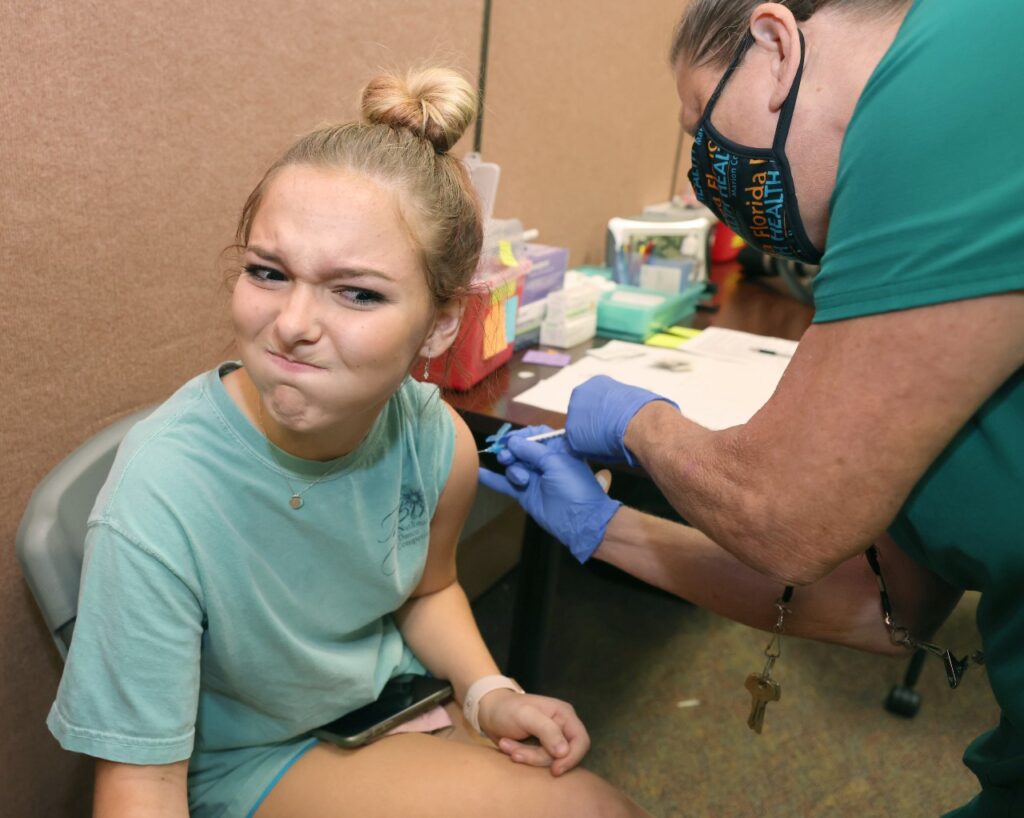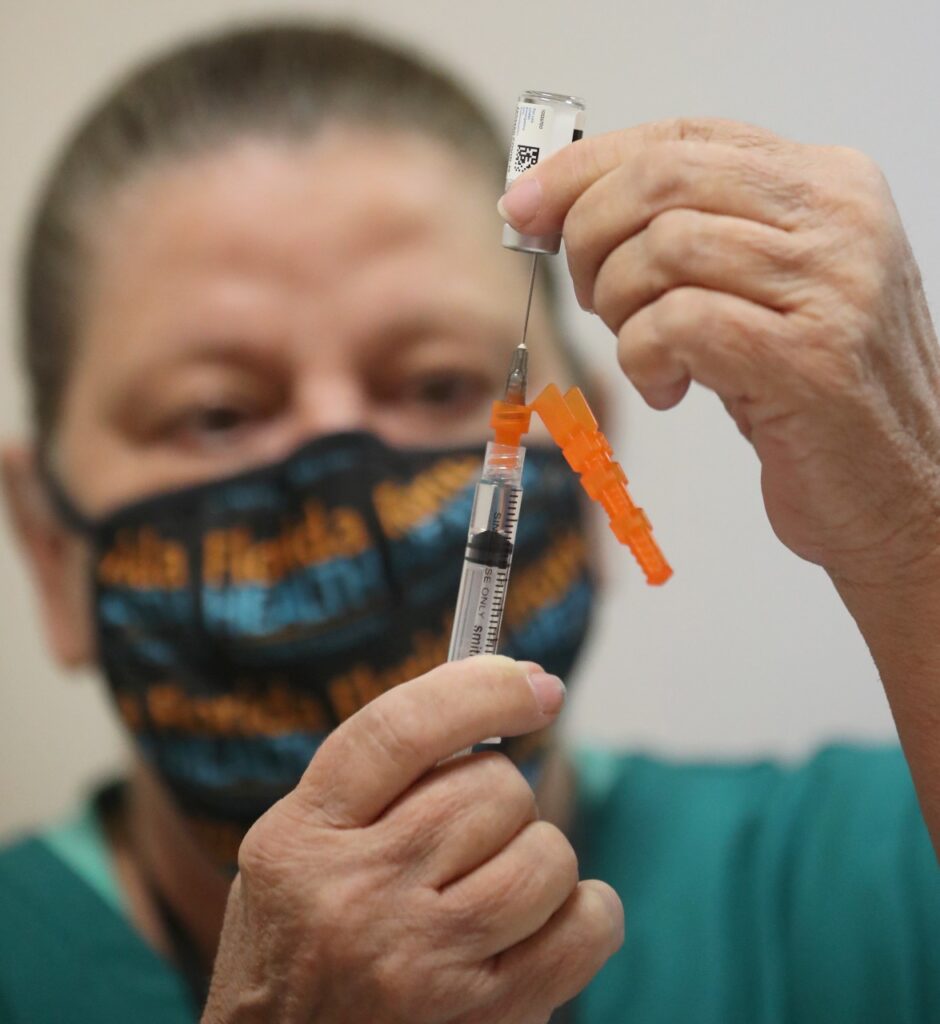Local COVID-19 cases in children rise, but remain manageable


Hayven Ostanik, 14, grimaces as she receives the Pfizer COVID-19 vaccination from Laura Moffatt, a RN, at the Florida Department of Health in Marion County in Ocala on Aug. 31. [Bruce Ackerman/Ocala Gazette]
Some parents are struggling to balance keeping their kids safe while letting them participate in daily activities like school, sports and playing with their friends.
“Last August before school started we had a very small number of kiddos having COVID… This August as school was starting, the number I read in one study showed a 1,400% increase just since the beginning of the summer,” said Dr. Stephanie Harrell a pediatrician with Pediatric Associates of Ocala.
Dr. Karen Martinez, a physician in the AdventHealth Ocala emergency room and the chair of the Department of Pediatrics said she has seen an increase in patients from last year.
“With the delta variant and the more recent wave, we have seen more kids presenting who are symptomatic and who ultimately have been positive,” she said.
Despite the higher numbers, in most cases, children have seen positive outcomes.
“Infants and newborns have had it, and honestly overall those infants and newborns have been very, very healthy and well. They are fine, they recover well and they do very well with COVID,” Harrell said.
Martinez noted, however, parents should be wary of fever in newborns up to 30 days old. She said that symptom, regardless of cause, needs to be examined.
While very young children have fared very well when compared to the overall population, older children struggle a little more, according to Harrell.
“The older kiddos have more risk of getting long-term illness or being more ill from the virus. So that’s why the vaccine manufacturers started studying from ages 12 to 16, because we were noticing the kids that were sick were the older kids, the adolescents and the high schoolers,” she said.
Not only is increasing age a factor, noted Martinez, but the overall health of the child matters too.
“When you get to that school age, to older adolescents, especially if they have comorbidities and things like asthma, those are the kids who are more likely to get sicker,” she said.
But it’s a relatively low number of children, according to Martinez.
Diagnosing children with COVID-19 can be tricky, both providers said, because symptoms can mimic other sicknesses, and so they both recommend testing as the quickest way to determine if a child has COVID-19.
Both providers also follow the American Academy of Pediatrics and Centers for Disease Control and Prevention guidelines when it comes to approved treatments, vaccines and masks.
Harrell understands the fear that is associated with having a COVID-19-positive child.
“You can not put them in a bubble,” Martinez pointed out, “and I don’t want parents blaming themselves if their kids get COVID, because it’s so widespread that no matter what you do, there’s always a risk.”
Harrell said there are few things parents can do for children if they get the virus other than rest and fluids, and maybe Tylenol depending on their age. Although vitamins, diet and sleep are all complementary, she said.
Vaccines
Another way to protect your child, according to the doctors, is to vaccinate them.
“Our studies and research show that for patients 12 and up the vaccine is safe and effective … it’s definitely our recommendation for as many kids as possible to get vaccinated in that 12 and over group,” Martinez said.
And while Harrell strongly supports vaccines, she also recognizes and understands the hesitations.
“It is so scary when this new stuff comes out very quickly and there’s not a lot of data about what to do. But the science and technology for this kind of vaccine have been around,” she said.
Martinez agreed.
“Even though mRNA vaccines in and of themselves are new, it’s actually something we’ve been looking at and studying for decades,” she said. “So even though this is the first widespread vaccine using mRNA, the science itself has existed for a long time.”
Hesitant parents, said Harrell, are to be expected.
“We definitely have these conversations every day with parents, and we understand that there is fear in giving a new vaccine to your child always, especially when you are responsible for their health.”

Laura Moffatt draws the Janssen COVID-19 vaccine into a syringe at the Florida Department of Health in Marion County in Ocala Aug. 31. [Bruce Ackerman/Ocala Gazette]
“It’s good to talk it out,” Harrell declared.
For parents who do have concerns, Harrell recommended speaking with the child’s healthcare provider.
“Really, the best thing to do is talk to your pediatrician if you have concerns about their medical history or certain vaccine adverse events in their past. And a kiddo that has had any adverse reactions to vaccines in the past, they need to talk to their pediatrician about getting it,” she said.
However, Martinez reiterated the benefits of children receiving the shots.
“These really are safe and effective vaccines,” she said. “It’s the number one way to help prevent any possible serious illness or long-term side effects COVID itself.”
Ultimately though, it is up to the parent. Even if a child between 12 and 17 is eligible, the parents have the final say on whether they receive the vaccine or not. For the children who do decide to get it, Harrell said their experience is similar to adults.
“Just like adults, it’s looking like they get a sore arm after the first one. And after the second one they can get tired, they have fevers, similar symptoms of the adults who are getting the Pfizer vaccine,” she said.
Regarding the upcoming vaccine for those children under 12, both providers were excited and enthusiastic about the possibility.
“Ideally, we’d like to cover as much of the population as possible as soon as the studies show it’s safe and effective for those populations,” Martinez said. “As it is approved I would love to see more and more kids younger and younger be able to get vaccinated because they affect ultimate spread, and they themselves are at risk for potentially serious illness.”
Harrell echoed those sentiments.
“I’m very excited about it. I think it would be a family-based decision, and a personal decision for those kids and that family… But as a pediatrician, I’m super excited about it and I would definitely recommend it once it comes out,” she said.
Martinez feels a connection with expectant mothers who are having to go through the process during a pandemic.
“As a previously pregnant woman during COVID, I have empathy for the concerns because I also delivered [recently],” she revealed. “The No. 1 thing for a newborn baby and a pregnant woman is to try and create what we call the cocoon environment.”
For a mom who is not yet vaccinated, vaccination after the first trimester will pass along immunity via the placenta and also breastfeeding if she chooses that option, and the baby’s father and other caregivers can take precautions to offer additional protections.
Masks
Both providers agreed masks are another way to keep children and their families safe when it comes to COVID.
“Especially in high-risk situations like indoors in larger groups, especially during school,” Martinez said when advising when children should wear masks.
“Obviously, if they’re in a low-risk situation outside playing, that kind of thing, masking is not essential. At that point I think it should go more on parent-child comfort,” she said.
Harrell too felt masks provide a substantial benefit.
“I definitely think masks cut down on sickness,” she said. “And since my ultimate job is to keep kids healthy, then I do recommend masks for kiddos. I recommend them for my family, and my kids, my nieces. I think they really, really cut down on illnesses last year.”
Keeping kids safe
Harrell and Martinez stressed there are multiple ways to keep children safe during the pandemic and the latest surge in cases. Handwashing, social distancing, avoiding small, indoor, closed spaces with limited ventilation, and making sure children wear a mask all are mitigation efforts, they said.
“Masking and vaccinations are eliminating, hopefully, that population that is going to get severely ill. Even if they’re vaccinated and get sick, we know they’re much more mild and shorter cases,” Martinez said.
Even though there may be light at the end of the tunnel related to the most recent rise in cases, Martinez believes there may still be a few slight bumps in the road ahead.
“A few weeks ago we were in a very different situation than we are now because our numbers are declining,” she noted. “They’re still decently high, but steadily declining, and hopefully continuing to trend in that direction. But some events will come up that might create continuing little spikes here and there.”
Harrell feels somewhat fatigued.
“We are all…doctors, nurses, schoolchildren, teachers, moms, dads, we are all just exhausted from this,” she admitted. She hopes thoughtfulness would stay on everyone’s mind.
“Be kind to one another,” she urged. “Be empathetic. Try not to be judgmental just because something is right for one person’s family doesn’t mean that is right for the next person’s family.”





